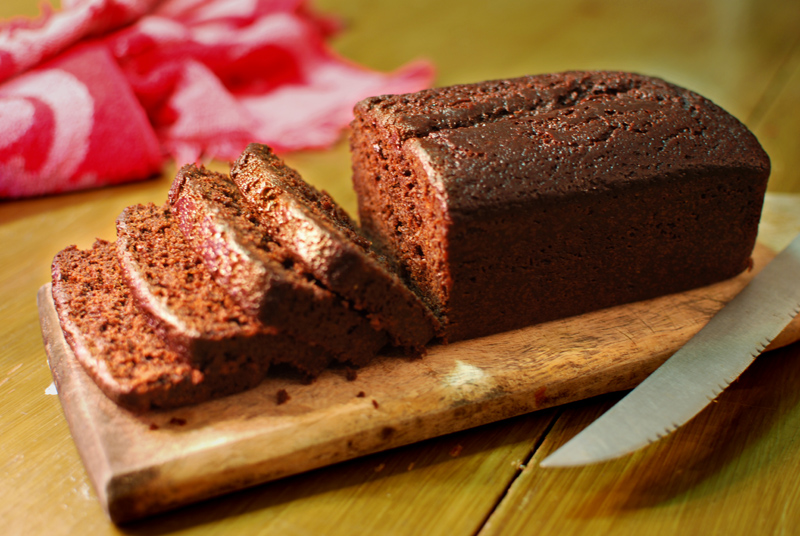Week Fifty-One: Gift Breads
Today’s bread comes to us from the inimitable M. F. K. Fisher, out of her book How To Cook A Wolf, published in 1942. Is it precisely a bread? Well, it has the word “bread” in the title, doesn’t it? Mystery solved.
This recipe is unlike many bread recipes I’ve made, though it’s not entirely unfamiliar. First, it uses a creaming method to combine shortening and sugar, a technique used mainly in cookie and cake recipes, after which wet and dry ingredients are added in intervals. Boiling water is used, as though you were making hot cocoa or certain chocolate cakes; and the sole egg is added at the end, after everything else has been combined.
It’s one of the stranger bread recipes I’ve seen, true; but it’s also one of the most delicious. Mrs. Fisher herself states without boast (but without any ingratiating false modesty, either) that it is the grandest gingerbread recipe she has ever seen. With such praise from such an authority, I was sure I couldn’t go wrong, and I was not disappointed.
This bread is robustly flavored, but in the most sophisticated way imaginable. The velvety texture holds together firmly, meaning that you will lose no moist crumbs to go diving after under the table. The black-as-night color might lead you to expect a slight burnt flavor, buy you’ll find nothing of the sort. Here is only the depth and simple comfort of ginger, cinnamon, and clove, enriched by the contemporary addition of candied ginger.
Though this loaf is certainly sweet, the brash acidity of molasses prevents it from becoming cloying. You could just as easily serve it for breakfast as you could for dessert; though when something is this exquisite, there’s really no bad time for it. Mrs. Fisher, however, suggests that no matter the hour, “unsalted butter, preferably pressed into little pats with a cow on one side and a daisy on the other, is the most fitting partner.” And if we knew all that she knew, I’m certain that we’d agree without hesitation, and whole-heartedly.
Gingerbread
Adapted from How To Cook A Wolf, by M. F. K. Fisher
Makes one 8 x 4 inch loaf
5 1/2 ounces (about 1 1/4 cups) unbleached all-purpose flour
1 teaspoon baking powder
1 teaspoon ground cinnamon
1 teaspoon ground ginger
1/4 teaspoon ground cloves
1/4 teaspoon salt
1/4 cup non-hydrogenated shortening
1/4 cup sugar
6 ounces (1/2 cup) molasses
3/4 teaspoon baking soda, divided
3/4 cup boiling water
1 large egg, beaten
2 tablespoons candied ginger, chopped finely
1. Preheat the oven to 325º F. Butter an 8 x 4 inch loaf pan, and sprinkle with a spoonful of flour, knocking the pan to remove any excess. Whisk together the flour, baking powder, cinnamon, ginger, cloves, and salt.
2. In the bowl of a stand mixer, cream together the shortening and the sugar with the paddle attachment, until thoroughly mixed. In a separate bowl, beat the molasses and 1/2 teaspoon baking soda with a nonstick spatula until light-colored and fluffy. Add the molasses to the shortening mixture, and beat until combined, scraping the bowl down as needed.
3. Add the remaining 1/4 teaspoon baking soda to the boiling water, and stir to dissolve. Alternate adding the water and the dry ingredients to the molasses mixture, in about three installments, scraping the bowl after each addition. When thoroughly mixed, fold in the beaten egg and the candied ginger.
4. Scrape the batter into the prepared pan, and bake at 325º F for about 35 minutes, or until fully baked and the center of the loaf feels firm when pressed gently on top. Begin checking the bread for doneness after 20 minutes in the oven, so as to not burn. Let cool briefly in the pan before turning out to cool thoroughly on a wire rack.
Notes:
1. Gingerbread will keep at room temperature, wrapped tightly, for up to a week. Frozen, it will keep for a month or so.

